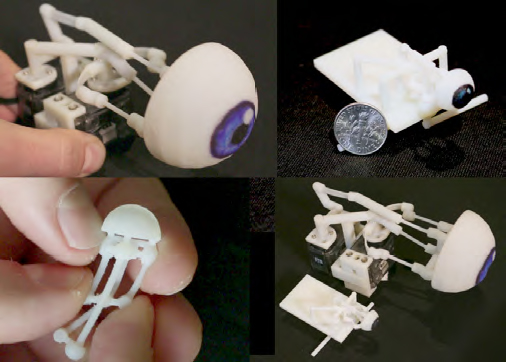Prototyped on a 3D printer, new toys from Disney Research demonstrate the use of a digital design tool to generate compliant mechanisms.
The mechanisms take inspiration from natural tendon and cartilage structure.
Considered to be “the nuts and bolts of organic machines” the joints can be applied to add another degree of flexibility to mechanical toys and walking robots.
This Disney Research demo has got wings – dragon wings. Clip via DisneyResearchHub on YouTube
From backpacks to robots
Typically made as a single (monolithic) piece, some everyday examples of compliant mechanisms are plastic backpack latches and shampoo lids.
“Compliant mechanisms enjoy widespread use in industry” explains Bernhard Thomaszewski, assistant professor at the University of Montreal.
“Even broader use in machines is attractive because of their precision and because they can be readily manufactured.”
Moritz Bacher, co-author of the Disney Research study adds, “Unfortunately, designing for flexibility is more difficult than for rigidity because it demands a deeper understanding of how materials behave as their shape changes,”
The flexi-hinge
To create a meaningful model for creating compliant mechanisms, the team at Disney digitally simulated the movement of a hinge design.
In place of a pin, the compliant hinge is designed to move using a central thread.

As a thin component of the compliant hinge, allowances are incorporated into the thread to make final designs more resilient to breakage.

For movement in a more complex object, i.e. steering a remote controlled car, the compliant hinges also need to be arranged next to each other. And so allowances are made avoid clashes between threads.
Dragons and eyes and cars
Once simulation studies are complete, the researchers prototype compliant hinges within the design of a mechanical Chebyshev Linkage model; dragon wings; a remote control car; an animatronic eye; and a bionic hand.

Each of the models are made using a Stratasys Connex 350 3D printer using the strong and flexible Rigur material.

More than just a toy
The design principles demonstrated in the Disney Research study can be translated beyond their use for making toys.
“machines as efficient and robust as those we find in nature.”
An effective method of generating compliant mechanisms could also find use in the design of mobile robots, and aquatic machines that require more water resistant parts.
A remote control car with optimized compliant steering. Clip via DisneyResearchHub on YouTube
In conclusion Markus Gross, vice president at Disney Research, adds,
“Rigidity is a concept foreign to the living world. From a kangaroo’s legs to the wings of a bat, bones, tendons and cartilage are the nuts and bolts of organic machines.”
“Our research team has developed a tool that will make it easier for us to eventually make our machines as efficient and robust as those we find in nature.”
The Disney Research team have also recently filed patents for an anti-scanning 3D printer filament, and a method for making a soft robotic mascot.
Interested in a career in materials research? Register on our 3D printing jobs site now.
To get all the latest 3D printing related studies delivered direct to your inbox, sign up to the most widely read newsletter in the industry. Get to-the-minute updates by following us on Twitter and liking us on Facebook.
Featured image: Disney’s computational research has wings, dragon wings. Photo via Disney Research



